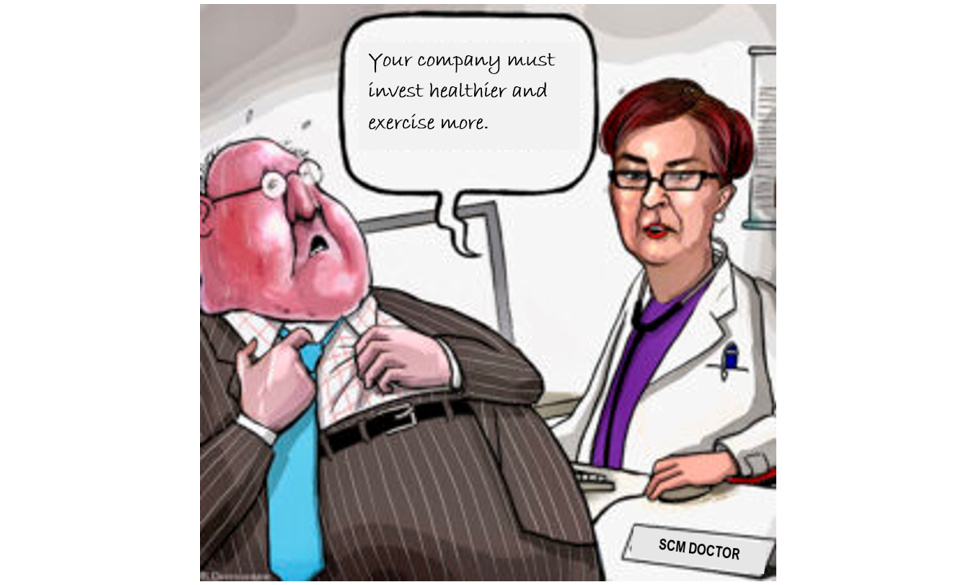Behavioural change is the best medicine for resilience

The world has changed. Are we heading towards the ‘old normal’, the ‘new normal’ or the ‘new abnormal’? No one knows, but let’s focus on looking ahead and keeping it relevant. It seems that the term ‘resilience’ is suddenly being presented – and not always appropriately – as the best solution for surviving the current crisis. Thankfully, supply chain resilience (SCR) is finally getting the attention it deserves.
Hooked up to the heart rate monitor
Being overweight and suffering a heart attack is an appropriate analogy for the situation in which many companies currently find themselves. Their doctor had warned them often enough. The excess weight gained as a result of too little exercise and too much (unhealthy) food had increased their risk factor. But it is difficult to change your behaviour. The realization that things really need to change only usually dawns when it’s too late and you’re hooked up to a heart rate monitor. Many companies have now reached that stage. If we define ‘resilient’ as ‘the ability to quickly revert back to a healthy state after a disruption’ then we can continue with this analogy. Leading a healthy lifestyle gives you no guarantees. However, it does reduce your risk of a heart attack, plus it will help your recovery if you should be unfortunate enough to suffer a heart attack after all. It gives you the resilience to rapidly revert to being your old self.
So how does SCR differ from the classic approach to risk management? Risk management starts with identifying the potential risks and then assessing them based on likelihood and impact. This is followed by setting priorities, deciding on possible mitigating actions and a follow-up plan. This approach works fine and is closely aligned with issues such as safety, for example. But things start to go wrong when we’re confronted with so-called ‘unknown unknowns’ (Black Swans such as the financial crisis, COVID-19, cyberattacks, etc.). These events can’t be assessed using the classic likelihood/impact method. The only way to deal with them is to be resilient. For many companies this will be essential in the ‘new normal’, when the world will be more unpredictable than ever.
Only yourself to blame?
The susceptibility of a supply chain to disruptions depends on its complexity and dynamism. Complexity often tends to increase, but that can sometimes be a strategic decision. Internal and external factors (e.g. internationalization, shorter product life cycles, promotional pressure, etc.) create a lot of dynamism in the supply chain. However, companies themselves are sometimes guilty of making their own supply chains more susceptible to disruptions. A strategy aimed at maximizing efficiency puts a company at particular risk and can lead to ‘efficiency anorexia’. For example, deciding to source all your raw materials from a single, low-cost supplier will be at the expense of flexibility and resilience and will make you vulnerable. The solution is to make the right trade-offs within your efficiency strategy in order to remain resilient. However, that requires you to provide visibility into the trade-offs and to make very deliberate choices.
 Improving your lifestyle
Improving your lifestyle
To return to the analogy again, SCR can be compared to making lifestyle changes. A new year’s resolution usually generates results in the first few weeks. But the only way to achieve a lasting effect is to change your lifestyle (i.e. your behaviour) by making improvements in several areas (e.g. exercise, diet) and monitoring whether you’re still on track – and by taking decisive action if you aren’t. Likewise, SCR can’t be seen as a kind of ‘quick-fix diet’. It has to be a lasting solution: SCR as a lifestyle choice.
But how? It’s not just a checklist, action plan or software tool. You need to tackle it more broadly than classic risk management. Besides the process-related and technical aspects, there is also a clear human side. For example, if your company culture means that everyone waits for instructions before taking action, then you’ve still got a long road ahead of you. So a broad, holistic approach is required, but if you don’t also make it relevant the initiative will be dead in the water and never achieve any results.
You’re not on your own
So what now? Do you still want to be fire-fighting after this crisis has passed? It is important for organizations to make a lasting lifestyle change and become resilient, but SCR is a pretty broad and complex concept. The best place to start is with the lessons learned. What worked, and what didn’t? After reflection, select the key lessons. This is also the perfect time to benefit from the current heightened attention from senior executives and make real progress. But don’t fall into the trap of purchasing unnecessary technology or tooling. There’s a huge range of fancy new tools that give you more transparency, for instance. Can they be a worthwhile investment? Certainly, especially in view of today’s technological possibilities such as artificial intelligence (AI) and Internet of Things (IoT). But just ask yourself: would you invest in an expensive new treadmill if you’re unlikely to ever use it? Who are you kidding? So set your mind to it, write a plan and start implementing it. Prevention is better than cure. Stay alert and make the right choices. Be ambitious, but don’t try to do everything at once. SCR is very broad. At the end of the day, you have to do it yourself – you’re the only one who can change your lifestyle – but make use of the available resources, the people and the support around you. You can’t do it alone. And don’t put it off. Tomorrow never comes, so start taking action today!



